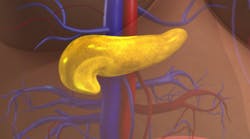Does periodontal disease drive pancreatic cancer?
If this question intrigues you, keep reading. It is a topic I keep stumbling across in my quest for current data on oral-systemic connections. It is also personal, as my husband is a 10-year pancreatic neuroendocrine cancer survivor. A recent article I read was compelling enough that I thought, “Wow! Clinicians really need to understand this.” Check out the title: “Periodontal pathogens in the etiology of pancreatic cancer.” It was published March 2017 in Gastrointestinal Tumors.1
Are oral pathogens the culprit?
It is troubling that pancreatic cancer is on the rise in the United States, and is currently the fourth leading cause of cancer-related deaths worldwide.2 The high mortality and economic burden this cancer leaves in its path warrants continued exploration of its etiology and reduction of all possible risk factors.
Is it possible that prevention of periodontal disease might be key to the prevention of pancreatic cancer? While intervention studies on humans to prove that theory have yet to be conducted, there is robust data that seems to implicate specific periodontal pathogens raising the risk for, and most likely contributing to, the development of pancreatic cancer. So, which pathogens? As with most other oral-systemic associations, Porphyromonas gingivalis shows up on the scene as a keystone pathogen, which basically means you don’t need a high volume to wreak havoc inside or outside the oral cavity.
One reason P. gingivalis is detrimental to health is because this bacterium can invade epithelial and endothelial tissues, hide from the immune system, and orchestrate dysbiosis (i.e., microbial imbalance) that promotes inflammation. Fusobacterium nucleatum and P. gingivalis have both been shown to stimulate tumorigenesis and tumor proliferation in oral cancer,3 so it is no surprise they appear to be important players in the development of pancreatic cancer.
Higher mortality for pancreatic and colorectal cancer
The presence of F. nucleatum detected in pancreatic cancer tissue correlates to a higher mortality4 similar to an elevated mortality observed in patients with colorectal cancer (CRC).5 What is it about this particular periodontal pathogen that influences cancer outcomes so significantly? Reported in a 2017 study on mice, once F. nucleatum was introduced into CRC cells, larger tumors and more rapid tumor development was observed compared to CRC cells without the presence of the pathogen. In addition, several inflammatory cytokines were elevated in the mice infected with F. nucleatum compared to those without.6
Recent data reveals that the presence of the F. nucleatum pathogen clinically and biologically influences colorectal cancer chemoresistance, leading to shorter survivals.5 It would not be surprising if future data confirms that the up-regulation of increased inflammatory markers, coupled with resistance to chemotherapeutic agents, are components of both the etiology and prognosis for colorectal and pancreatic cancers in humans that harbor specific periodontal pathogens.
That’s not all
A fascinating study published in the Journal of the American Medical Association in 2016 should pique the interest of all dental professionals.7 They took 14,000 saliva samples from healthy individuals who did not have pancreatic cancer and followed them for 10 years. Three hundred sixty-one individuals developed pancreatic cancer, so they did a DNA salivary assessment of those with cancer and compared the bacteria present to those who did not have pancreatic cancer. The results revealed that individuals had a 59% greater risk of pancreatic cancer when P. gingivalis was present, and they had a 50% greater risk when the oral pathogen Aggregatibacter actinomycetemcomitans was present.
So, if you are counting, research reveals there are at least three oral pathogens that appear to be wreaking havoc in distant sites that likely influence the development of pancreatic cancer. Did you know that less than 10% of those diagnosed with pancreatic cancer will still be alive in five years?8
My suggestion is that you share this information with other dental team members. Talk about the significance of early detection and definitive treatment of periodontal disease for all of your patients. Make sure your patients are well equipped to remove disease-causing biofilm daily. Educate them on the importance of maintaining closely monitored intervals for ongoing dental hygiene care. Begin using salivary diagnostics to identify high-risk pathogens if you aren’t already doing so. Don’t wait until studies implicate more chronic illnesses and cancers associated with periodontal disease to take your role more seriously than ever before. The stakes are high.
References
1. Ögrendik M. Periodontal pathogens in the etiology of pancreatic cancer. Gastrointest Tumors. 2017;3(3-4):125-127. doi:10.1159/000452708.
2. Jemal A, Bray F, Center MM, Ferlay J, Ward E, Forman D. Global cancer statistics. CA Cancer J Clin. 2011;61(2):69-90. doi:10.3322/caac.20107.
3. Binder GA, Fischman S, Revach B, et al. Periodontal pathogens Porphyromonas gingivalis and Fusobacterium nucleatum promote tumor progression in an oral-specific carcinogenesis model. Oncotarget. 2015;6(26):22613-22623.
4. Signoretti M, Roggiolani R, Stornello C, Delle Fave G, Capurso G. Gut microbiota and pancreatic cancer. Minerva Gastroenterol Dietol. 2017;63(4):399-410. doi:10.23736/S1121-421X.17.02387-X.
5. Yu T, Guo F, Yu Y et al. Fusobacterium nucleatum promotes chemoresistance to colorectal cancer by modulating autophagy. Cell. 2017;170(3):548-563. doi:10.1016/j.cell.2017.07.008.
6. Yang Y, Wen W, Peng J, et al. Fusobacterium nucleatum increases proliferation of colorectal cancer cells and tumor development in mice by activating toll-like receptor 4 signaling to nuclear factor-kB, and up-regulating expression of microRNA-21. Gastroenterology. 2017;152(4):851-866. doi: 10.1053/j.gastro.2016.11.018.
7. Jacob JA. Study links periodontal disease bacteria to pancreatic cancer risk. JAMA. 2016;315(24):2653–2654. doi: 10.1001/jama.2016.6295.
8. Cancer stat facts: Pancreatic cancer. National Cancer Institute website. https://seer.cancer.gov/statfacts/html/pancreas.html. Accessed October 1, 2018.
Karen Davis, BSDH, RDH, is the founder of Cutting Edge Concepts, an international continuing education company, and practices dental hygiene in Dallas, Texas. She is an independent consultant to the Philips Corp., Periosciences, and Hu-Friedy/EMS. She can be reached at k[email protected].
